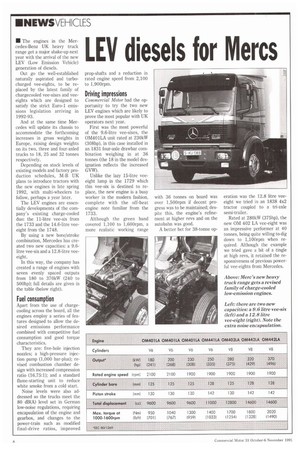LEV diesels for Meru
Page 10

If you've noticed an error in this article please click here to report it so we can fix it.
/ The engines in the Mercedes-Benz UK heavy truck range get a major shake-up next year with the arrival of the new LEV (Low Emission Vehicle) generation of diesels.
Out go the well-established naturally aspirated and turbocharged vee-eights, to be replaced by the latest family of chargecooled vee-sixes and veeeights which are designed to satisfy the strict Euro-1 emissions legislation arriving in 1992-93.
And at the same time Mercedes will update its chassis to accommodate the forthcoming increases in gross weights in Europe, raising design weights on its two, three and four-axled trucks to 18, 25 and 32 tonnes respectively.
Depending on stock levels of existing models and factory production schedules, M-B UK plans to introduce tractors with the new engines in late spring 1992, with multi-wheelers to follow, perhaps a year later.
The LEV engines are essentially developments of the company's existing charge-cooled duo: the 11-litre vee-six from the 1733 and the 14.6-litre veeeight from the 1748.
By using a new bore/stroke combination, Mercedes has created two new capacities: a 9.6litre vee-six and a 12.8-litre veeeight.
In this way, the company has created a range of engines with seven evenly spaced outputs from 180 to 370kW (240 to 500hp); full details are given in the table (below right).
Fuel consumption
Apart from the use of chargecooling across the board, all the engines employ a series of features designed to allow the desired emissions performance combined with competitive fuel consumption and good torque characteristics.
They are: five-hole injection nozzles; a high-pressure injection pump (1,000 bar-plus); revised combustion chamber design with increased compression ratio (16.75:1); and a standard flame-starting unit to reduce white smoke from a cold start.
Noise levels were also addressed so the trucks meet the 80 dB(A) level set in German low-noise regulations, requiring encapsulation of the engine and gearbox, and changes to the power-train such as modified final-drive ratios, improved prop-shafts and a reduction in rated engine speed from 2,100 to 1,900rpm.
Driving impressions
Commercial Motor had the opportunity to try the two new LEV engines which are likely to prove the most popular with UK operators next year.
First was the most powerful of the 9.6-litre vee-sixes, the 0M401LA unit rated at 230kW (308hp), in this case installed in an 1831 four-axle drawbar combination weighing in at 36 tonnes (the 18 in the model designation reflects the increased GVW).
Unlike the lazy 15-litre veeeight lump in the 1729 which this vee-six is destined to replace, the new engine is a busy worker in the modern fashion, complete with the off-beat engine note familiar from the 1733.
Although the green band covered 1,100 to 1,600rpm, a more realistic working range with 36 tonnes on board was over 1,500rpm if decent progress was to be maintained; despite this, the engine's refinement at higher revs and on the autobahn was good.
A better bet for 38-tonne op eration was the 12.8 litre veeeight we tried in an 1838 4x2 tractor coupled to a tri-axle semi-trailer.
Rated at 280kW (375hp), the new OM 402 LA vee-eight was an impressive performer at 40 tonnes, being quite willing to dig down to 1,100rpm when required. Although the example we tried gave a bit of a tingle at high revs, it retained the responsiveness of previous powerful vee-eights from Mercedes.




















































































